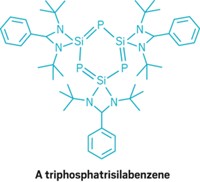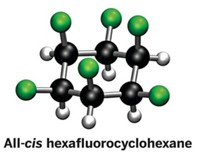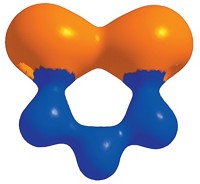Advertisement
Grab your lab coat. Let's get started
Welcome!
Welcome!
Create an account below to get 6 C&EN articles per month, receive newsletters and more - all free.
It seems this is your first time logging in online. Please enter the following information to continue.
As an ACS member you automatically get access to this site. All we need is few more details to create your reading experience.
Not you? Sign in with a different account.
Not you? Sign in with a different account.
ERROR 1
ERROR 1
ERROR 2
ERROR 2
ERROR 2
ERROR 2
ERROR 2
Password and Confirm password must match.
If you have an ACS member number, please enter it here so we can link this account to your membership. (optional)
ERROR 2
ACS values your privacy. By submitting your information, you are gaining access to C&EN and subscribing to our weekly newsletter. We use the information you provide to make your reading experience better, and we will never sell your data to third party members.
Synthesis
Molecules of the Year
C&EN highlights some of the coolest compounds reported in 2016
December 15, 2016
| A version of this story appeared in
Volume 94, Issue 49

First confirmed inorganic double helix
Chemists led by Tom Nilges of the Technical University of Munich reported the first completely inorganic double-helix compound, SnIP, which is a semiconducting material featuring a twisted tin iodide (SnI+) chain intertwined with a twisted phosphide (P–) chain. The chains are held together by weak interactions between tin and lone pairs of electrons on phosphorus, and each double helix is coordinated to neighboring ones by interactions that are stronger than hydrogen bonding in DNA (Adv. Mater. 2016, DOI: 10.1002/adma.201603135).
Presenting a ferrocene Ferris wheel
By directly fusing ferrocene molecules together, Michael S. Inkpen, Nicholas J. Long, and Tim Albrecht of Imperial College London and their colleagues prepared new iron-based macrocycles that resemble a Ferris wheel. The redox-active nanorings, with versions containing five to nine ferrocene units, offer possibilities for trapping ions or molecules to sense or control them, as well as for electronic and magnetic applications (Nat. Chem. 2016, DOI: 10.1038/nchem.2553).
Cesium hosts 16 fluorine atoms
Klaus-Richard Pörschke and coworkers of the Max Planck Institute for Kohlenforschung reported a new molecule in which a central cesium atom is coordinated by an unprecedented 16 fluorine atoms from five anion units. Matching the large, singly charged Cs+ cation with the weakly coordinating [H2NB2(C6F5)6]– anion allowed the researchers to go beyond 12 bonds in a complex for the first time without using hydrogen as one of the coordinating ligands. It also was the first time scientists achieved 16 bonds to one metal, which is thought to be the maximum possible (J. Am. Chem. Soc. 2016, DOI: 10.1021/jacs.6b02590).
Chemists’ choice: Molecule of the Year
Researchers reported a lot of exciting new molecules in 2016. C&EN picked its favorites, listed on this page, then asked online viewers to vote on theirs. Here are the results:
Molecule
Nitrido-imido-amido complex: 31%
World’s most polar neutral molecule: 28%
Ferrocene Ferris wheel: 14%
World’s strongest chemical base: 10%
16-Coordinate cesium-fluorine complex: 8%
Inorganic double helix: 7%
Compound with four group 15 elements: 2%
Source: Results based on an online C&EN poll, held Dec. 6-14.
Chromium complex wins bonding triple crown
In 1978, David N. Clark and Richard R. Schrock of Massachusetts Institute of Technology reported a tungsten alkyl-alkylidene-alkylidyne complex notable for being the first compound containing single, double, and triple metal-ligand carbon bonds in the same molecule. Fast-forward to this year, and Evan P. Beaumier and Aaron L. Odom of Michigan State University and their colleagues reported the first nitrogen analog, a chromium amido-imido-nitrido complex (Chem. Sci. 2016, DOI: 10.1039/c5sc04608d).
Pnictogens make chain-link progress
Alexander Hinz of Oxford University and Axel Schulz and Alexander Villinger of the University of Rostock thought it would be nice to make a heterocyclic ring containing four different pnictogens (group 15 elements, N to Bi). They ended up unable to close the linear precursor to make the ring, but the acyclic compound still included an unprecedented Sb–N–As=P chain. The researchers say that in principle it should be possible to include bismuth, which would be a periodic table first to incorporate all elements from one group in a molecular complex (Chem. Eur. J. 2016, DOI: 10.1002/chem.201601916).
New world champion base and polar molecule crowned
By preparing the o-diethynylbenzene dianion in a gas-phase experiment, Berwyck Poad of Queensland University of Technology and coworkers set the record for theworld’s strongest chemical base, as measured by the molecule’s proton affinity. The dianion is strong enough to deprotonate benzene in the gas phase, the researchers say, and its proton affinity record is unlikely to be broken (Chem. Sci. 2016, DOI: 10.1039/c6sc01726f). Meanwhile, a research team led by Klaus Müllen of the Max Planck Institute for Polymer Research made a hexasubstituted benzene in which electron-withdrawing cyano groups and electron-donating amino groups combine to pull and push the molecule’s electron density in the same direction. This compound is remarkable for being the most polar neutral molecule now known to exist (Angew. Chem. Int. Ed. 2016, DOI: 10.1002/anie.201508249).
C&EN's YEAR IN REVIEW
Top Headlines of 2016
- Hawaii explosion cost a researcher an arm
- TSCA reform crossed the finish line
- U.S. elected Trump as president
- The periodic table got four new elements
- Post Dow-DuPont, chemical deal-making waned as 2016 advanced
- Labs made advances in Zika research
- Four ag giants to rule them all
- 2016 Nobel Prize in Chemistry at a glance
- Brexit bomb exploded
- Focus returned to Iran's chemical industry
- Overtime pay limit doubles under Obama administration
- The CRISPR craze continued
- Perfluorinated compounds got increased scrutiny
- From the lab to the market
- Paris Agreement to curb climate change took off
- World chemical production at a glance
- Flint's water woes lingered
- As China's economy slowed, chemical makers adjusted
- Mostafa A. El-Sayed won the 2016 Priestley Medal
- ACS members on average fared better than young graduates in employment surveys
- ACS invests internationally
- Spun-off firms found their footing in 2016
- Remembering the Nobel laureates we lost in 2016
- ACS proposed chemistry preprint server
- Berkeley College of Chemistry avoided reorganization
- Fight against opioid epidemic continued in 2016
- Noble gas shortages averted, for now
- The shale gas boom by the numbers
- Crop protection products in the crosshairs
- ACS launched new journals
- Website search terms of the year
- Biobased materials hit the big time
- No better deal emerged for Mossville, La.
- U.S. prepares for national food labeling standard
Top Research of 2016
- Mini factory made drugs on demand
- World's first PET-munching microbe discovered
- Liquid metals went to work
- Methylene activation reached new heights
- Biological structures of the year
- Wearable sensors were 'the' fashion accessories of 2016
- Scientists beefed up the antibiotic arsenal
- An enzymatic route to carbon-silicon bonds
- Single-atom catalysts gained a toehold
Revisiting Research of 2006













Join the conversation
Contact the reporter
Submit a Letter to the Editor for publication
Engage with us on Twitter